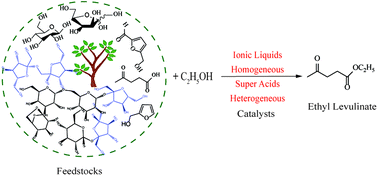Catalytic and mechanistic insights into the production of ethyl levulinate from biorenewable feedstocks
Abstract
The importance of ethyl levulinate (EL) as a fuel additive and a potential biomass-derived platform molecule is noteworthy. EL is obtained from the esterification of levulinic acid (LA) in the presence of ethanol. Besides LA, the acid-catalyzed ethanolysis reaction to produce EL can be carried out on a variety of biomass-derived substrates including furfuryl alcohol (FAL), chloromethyl furfural, monosaccharides, polysaccharides and lignocellulosic biomass. The acid catalysts employed for such conversions cover a wide range of structure and properties. The nature of the acid catalysts and the key intermediates formed during the reaction dictate the overall yield of the desired product. For example, in the ethanolysis reaction of FAL to produce EL, diethyl ether (DEE) and ethoxymethylfuran (EMF) produced as side products are suggested to influence the selectivity of EL. Similarly, in the ethanolysis of glucose, formation of ethyl-D-glucopyranoside (EDGP) results in a slow conversion to product EL. The review, therefore, focuses on highlighting the importance of catalyst structure, acidity and reaction mechanism and the role of key intermediates in the production of EL from biorenewable resources.


 Please wait while we load your content...
Please wait while we load your content...